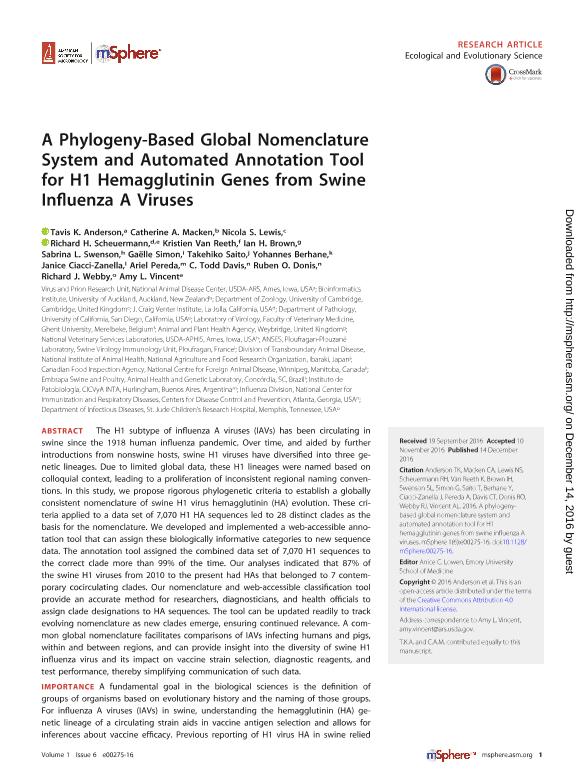Artículo
A phylogenybased global nomenclature system and automated annotation tool for H1 hemagglutinin genes from swine influenza A viruses
Anderson, Tavis K.; Macken, Catherine A.; Lewis, Nicola S.; Scheuermann, Richard H.; Van Reeth, Kristien; Brown, Ian H.; Swenson, Sabrina L.; Simon, Gaëlle; Saito, Takehiko; Berhane, Yohannes; Ciacci Zanella, Janice; Pereda, Ariel Julián ; Davis, C. Todd; Donis, Ruben O.; Webby, Richard J.; Vincent, Amy L.
; Davis, C. Todd; Donis, Ruben O.; Webby, Richard J.; Vincent, Amy L.
 ; Davis, C. Todd; Donis, Ruben O.; Webby, Richard J.; Vincent, Amy L.
; Davis, C. Todd; Donis, Ruben O.; Webby, Richard J.; Vincent, Amy L.
Fecha de publicación:
11/2016
Editorial:
American Society for Microbiology
Revista:
mSphere
ISSN:
2379-5042
Idioma:
Inglés
Tipo de recurso:
Artículo publicado
Clasificación temática:
Resumen
The H1 subtype of influenza A viruses (IAVs) has been circulating in swine since the 1918 human influenza pandemic. Over time, and aided by further introductions from nonswine hosts, swine H1 viruses have diversified into three genetic lineages. Due to limited global data, these H1 lineages were named based on colloquial context, leading to a proliferation of inconsistent regional naming conventions. In this study, we propose rigorous phylogenetic criteria to establish a globally consistent nomenclature of swine H1 virus hemagglutinin (HA) evolution. These criteria applied to a data set of 7,070 H1 HA sequences led to 28 distinct clades as the basis for the nomenclature. We developed and implemented a web-accessible annotation tool that can assign these biologically informative categories to new sequence data. The annotation tool assigned the combined data set of 7,070 H1 sequences to the correct clade more than 99% of the time. Our analyses indicated that 87% of the swine H1 viruses from 2010 to the present had HAs that belonged to 7 contemporary cocirculating clades. Our nomenclature and web-accessible classification tool provide an accurate method for researchers, diagnosticians, and health officials to assign clade designations to HA sequences. The tool can be updated readily to track evolving nomenclature as new clades emerge, ensuring continued relevance. A common global nomenclature facilitates comparisons of IAVs infecting humans and pigs, within and between regions, and can provide insight into the diversity of swine H1 influenza virus and its impact on vaccine strain selection, diagnostic reagents, and test performance, thereby simplifying communication of such data.
Archivos asociados
Licencia
Identificadores
Colecciones
Articulos(SEDE CENTRAL)
Articulos de SEDE CENTRAL
Articulos de SEDE CENTRAL
Citación
Anderson, Tavis K.; Macken, Catherine A.; Lewis, Nicola S.; Scheuermann, Richard H.; Van Reeth, Kristien; et al.; A phylogenybased global nomenclature system and automated annotation tool for H1 hemagglutinin genes from swine influenza A viruses; American Society for Microbiology; mSphere; 1; 6; 11-2016; 1-14
Compartir
Altmétricas



